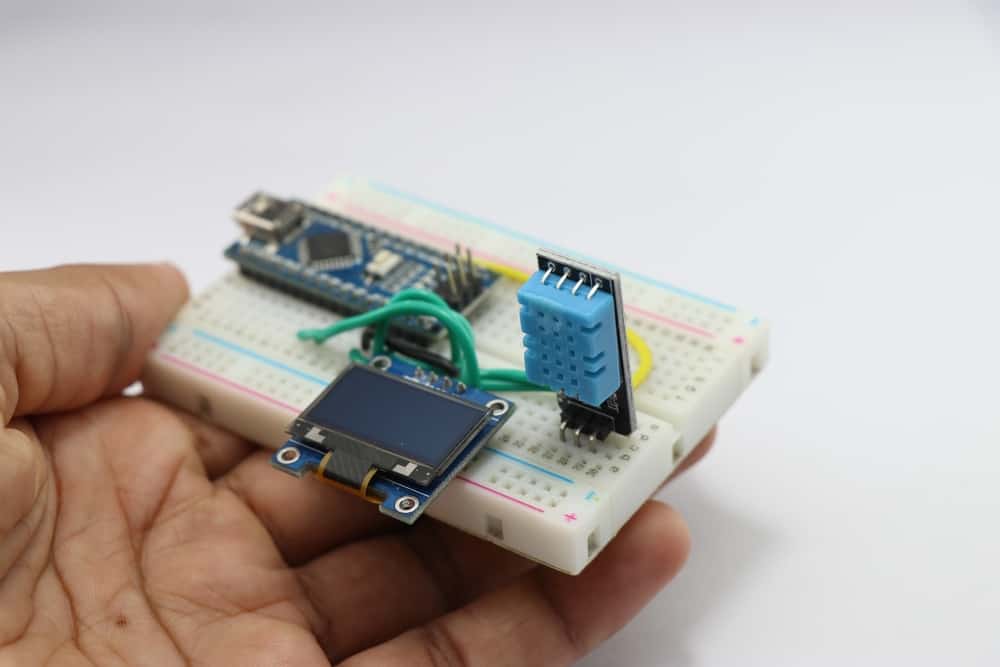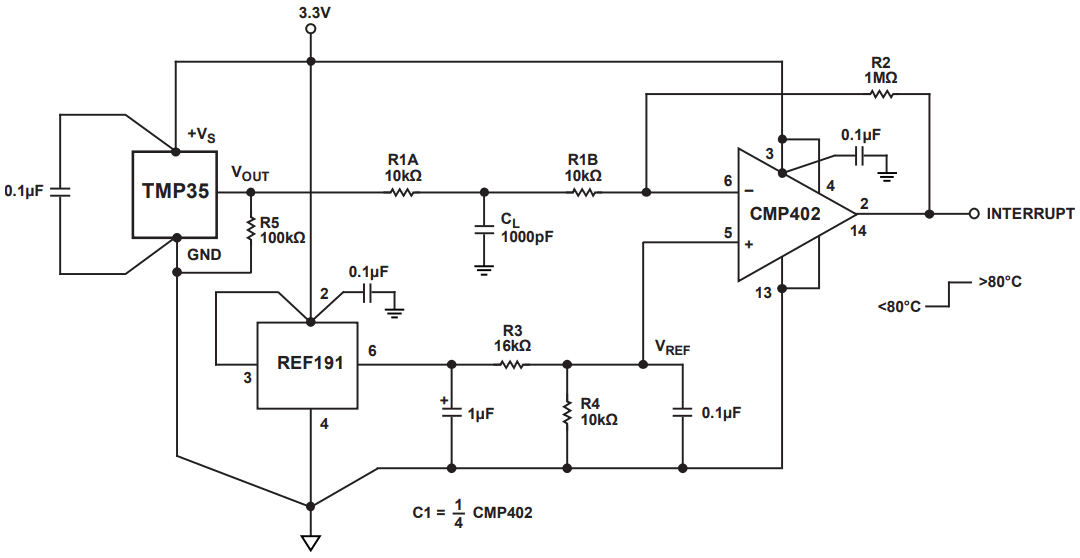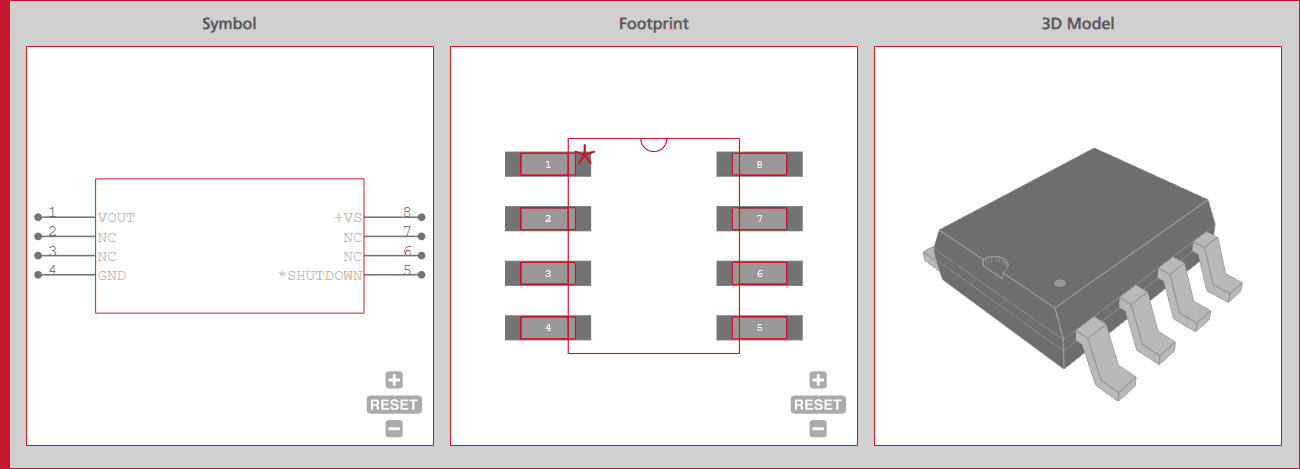
So many systems need temperature tracking and compensation, and these features are often integrated into the system. Temperature sensor chips operate quietly in the background without being apparent to the user, but they are essential for activating thermal management systems in complex electronics. Compared to large industrial temperature probes and sensors, the temperature measurement system on a PCB needs to be much smaller, use lower power, and be mountable directly on the board.
The TMP36 is one popular example of a highly accurate temperature sensor that operates with low voltage over a broad range. The TMP36 comes in multiple packages that provide a low-profile option for temperature sensing directly on the PCB or a standing option that can protrude through an enclosure. Before selecting a temperature sensor, consider these points in the TMP36 datasheet to see if this temperature sensor is best suited for your system.
TMP36 Datasheet and Specifications
The TMP36 from Analog Devices is a low-profile temperature sensor that mounts directly to the surface layer of a PCB. These components have continuous analog output with high linearity and low offset voltage, producing under 1 V at maximum output with <1 mW power consumption at full scale. The sensor operates as a band gap core comprising 3 BJTs biased at micro-ampere current levels. This component’s available packaging options and low power consumption make it very versatile in applications where board-level temperature measurements are required.
Specifications
Some of the main specifications found in the TMP36 datasheet include:
- Input power: 2.7 to 5.5 V
- Temperature range: -40 to +125 °C
- Typical accuracy: ±1 °C at +25 °C, ±2 °C from −40 to +125 °C
- External calibration: Not required
- Output scale factor: 10 mV/ °C
- Output impedance: Low
- Regulation: 0.03 °C/V equivalent PSRR
In total, there are three variants of this component (TMP35/TMP36/TMP37). These each has slightly different specifications and share the same datasheet. Be sure to check the datasheet before selecting one of these variant components.
Interfacing with a Host Processor
There are two ways the TMP36 can interface with a host processor and have its output converted to data: through a dedicated ADC IC with high resolution or directly to the ADC pin on a host processor. Once interfaced with an ADC, the continuous output voltage will need to be transformed to a quantized temperature value in the host processor to be helpful to the device user. The value can then be used in logical operations in the device’s application.
The low output impedance and voltage-controlled output allow the component to be interfaced with capacitive loads, such as unterminated GPIOs or a dedicated ADC. Instantiation of an ADC feature on a GPIO will give the same results as a dedicated high-resolution ADC as long as the load capacitance is not too far outside specification. The component is rated to have zero ringing when interfaced with capacitive loads ranging from 1 to 10 nF. In cases where the load capacitance is too low, as in many ICs, the output should be compensated either to bring load capacitance in-range (shunt capacitance) or to dampen any oscillation (series resistance).
Application: Microprocessor Interrupt
One common application of a temperature sensor IC is a temperature-triggered interrupt for an MCU, FPGA, or other IC that may be in danger of overheating. This application requires no ADC or temperature calculation on a host controller, and it can be implemented as long as the protected component has an enable pin. This application follows a simple signal chain:
- Use a comparator to track when the sensor’s output voltage exceeds some reference
- If the enable pin is active-low, then connect the comparator output to the protected component’s
- If the enable pin is active-high, then use the comparator output to switch a transistor that pulls the enable pin low
Steps 2 or 3 will switch off the target IC when the chosen temperature threshold is exceeded. Again, this can be implemented with only two other ICs and some passives: an analog comparator, a precision voltage reference (e.g., silicon bandgap reference), and some resistors and capacitors. An example application circuit from the TMP36 datasheet is shown below. This application circuit uses the TMP35, although it can easily be implemented with the TMP36.

Microprocessor interrupt circuit, from Figure 30 in the TMP36 datasheet.
Packaging
The TMP36 is available in SMD and through-hole packages; the same applies to the variants for this part. Available packages for the TMP36 are SOIC-8, TO-92, and SOT-23. These packages have different thermal resistance values, with the SOT-23 variant having the highest junction-to-case and junction-to-air thermal resistance values. Therefore, the SOIC-8 and TO-92 components are better suited for use in higher temperature environments. If an opening is placed in the device enclosure, the TO-92 package could be used to take a temperature reading external to the PCB environment.

Example symbol, footprint, and 3D model of the package for TMP36 from Analog Devices.
When you need to find footprints, application notes, and the TMP36 datasheet, you can quickly find the components you need with the parts search features in Ultra Librarian. The Ultra Librarian platform gives you access to PCB footprints, technical data, and ECAD/MCAD models alongside sourcing information to help you stay ahead of supply chain volatility. All ECAD data you’ll find on Ultra Librarian is compatible with popular ECAD applications and is verified by component manufacturers to help streamline your designing process.
Working with Ultra Librarian sets up your team for success to ensure streamlined and error-free design, production, and sourcing. Register today for free.








